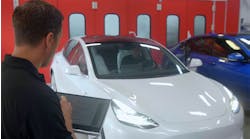Load leveling. Balancing your workload. That has become a point of emphasis at my three shops in Anchorage, Ak.
We want to use our facilities the best way we can.
And each of the three facilities is laid out totally different from the others. So, by looking at what makes the most sense for that facility, we’ll be able to take care of our customers in the most ideal manner possible.
We have one facility with a drive-in estimating bay. And, in the winter, the more vehicles we can run through that—where we have the opportunity to go over that car with the customer in a nice, warm, well-lit situation—the more success we’re going to have. And, we have facilities with lots of garage doors, and some with just two. So, the better we can control the situation, the better success we’ll have.
There are a couple keys to load leveling. First, you have to factor in what each of your facilities produces. At my shops, our employees work in teams, and we track our teams on a daily basis in terms of how many hours per day each is producing. Those numbers will change on occasion, of course, because you’ll have guys go on vacation, you’ll have guys out sick, you’ll have new hires and so forth. But, in general, us being in tune with what our teams are actually producing is important.
Then, we also look at what our average supplement and tow-ins are, and what our unexpected, or unplanned, amount of hours are. Our goal is that, if one shop’s booked out for two weeks, then all shops are booked out for two weeks. We don’t want one shop booked out for a month and another one booked out one week.
But, to accomplish that ideal balance, we have to know our production numbers. We have to know what each facility is producing―and not what they did last year, and not what they did six months ago. We need to know, for this pay period, what that facility is accomplishing.
Administratively, we have one team that covers all three of our locations. So, my administrative staff doesn’t care where a car gets fixed. They just want to know that it’s going to get fixed by our organization.
Originally, each of my facilities had their own administrative team, and what I found in that process was that, when that was the case, an estimator would write the estimate, and if the best shop for that vehicle was to go to a different location, then the estimator was, theoretically, not getting paid for the work that they did on that vehicle. Because we’re commission-based, even with administration.
So, we eventually combined all locations, from an administrative perspective, so that estimators don’t care where a vehicle goes.
And now I’m able to move administrators to the bottlenecks. So, if we end up with, say, 10 vehicles at one shop that all need administrative support, we can move people for a day and say, “Go get them caught up.” Basically, we can move our resources to where there’s a problem. And we do that often.
My tow-in facility has a very small office, so, we’ve tried reducing the amount of customers that facility deals with to three cars per day. My other two facilities are over 10 cars per day. Of course, the more cars you have, the more customer interaction you have and, as a result, the more office space you need. We’ve found that, if we have less traffic in that small office, then it works out better.
The bottom line is this: If we can use our facilities correctly, we can serve the customer better, which, at the end of the day, is all that really matters.



